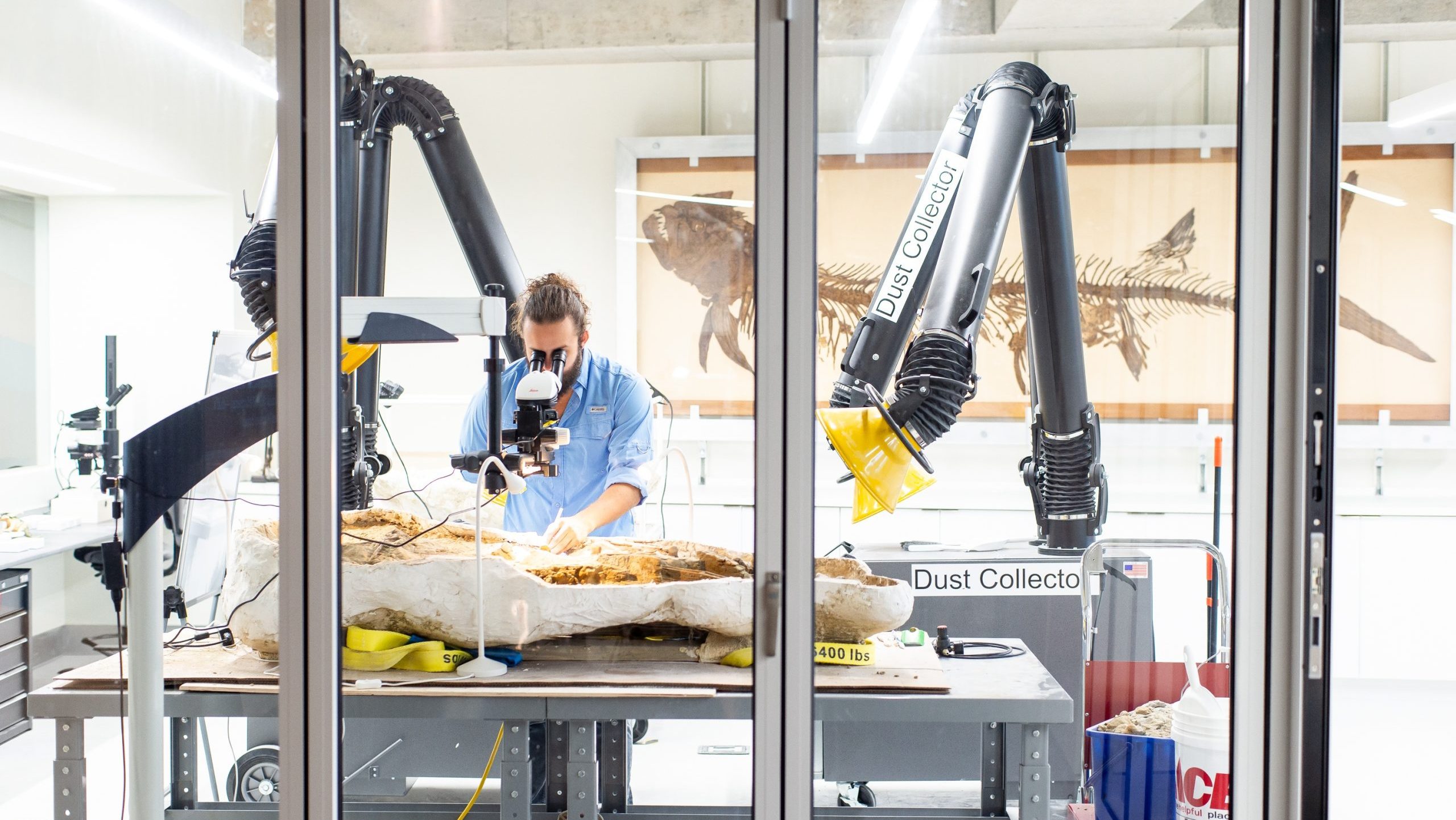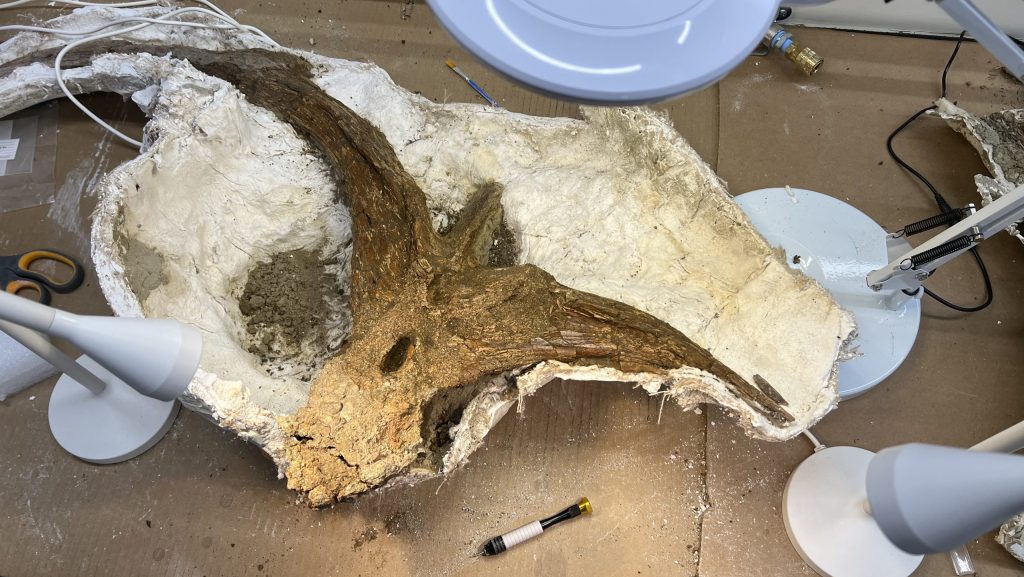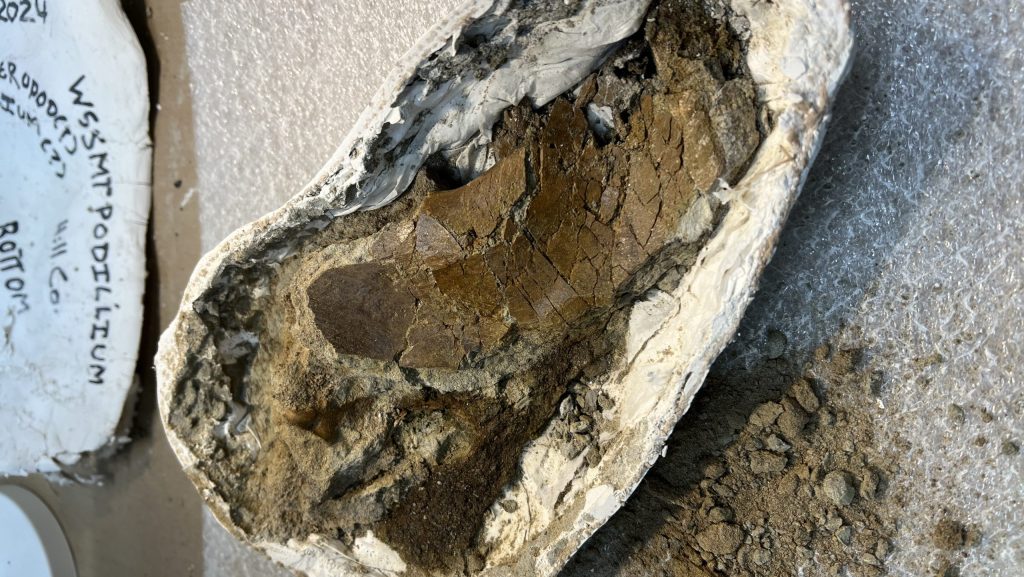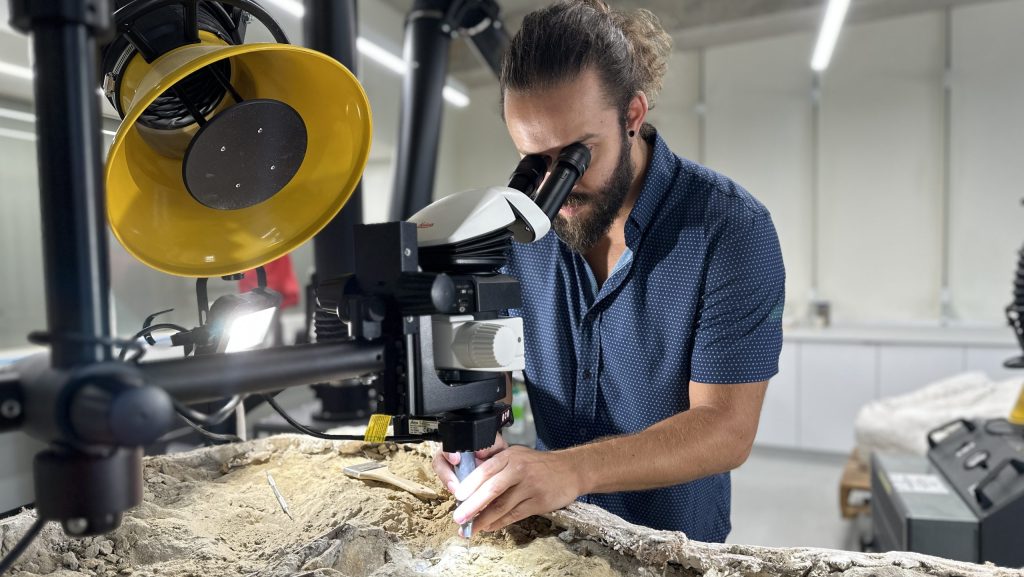
Dan Large is Frost Science’s fossil preparator. He cleans and prepares the fossils that Dr. Cary Woodruff, the museum’s curator of vertebrate paleontology, excavates in Montana. Once a fossil arrives in Miami, Dan painstakingly cleans away the rock and other material it is buried in to reveal the secrets it holds. Each fossil can take thousands of hours to prepare. Follow along with Dan to learn what adventures a day of work in the PaleoLab holds!
8:00 a.m.: I arrive at Frost Science and go to the PaleoLab. I drop off my bags and get to work.
8:15 a.m.: Today I’m working on a fossil Cary collected last summer from a location nicknamed “Sandcastle,” a reference to the extremely soft matrix in which its fossils are preserved. Normally I need powerful tools like air scribes to remove matrix from the bones, but not for this one! It is preserved in a sandstone so soft I can break the rock down with my fingernails. I don’t; instead, I use a carbide pin to slowly remove it.

9:17 a.m.: My eyes are bleary. To ensure I don’t damage the bone, I’ve been working under a microscope for nearly an hour. I know this fossil is a vertebra from an ankylosaur, an armored dinosaur, but I can’t currently tell what species it was. I hope that at some point while working with this fossil, I’ll find a unique feature that can help identify which species it is from.
9:30 a.m.: Excitement! I uncover a small, lumpy bone no larger than a pencil eraser. It is an ossicle, a tiny piece of armor that was embedded in the dinosaur’s skin. I’ve already found several others from this fossil. I place it in an acid free paper tray and document the discovery.
10:45 a.m.: I’ve finally managed to expose a new area of bone around this vertebra. I now need to stabilize this section of bone, which I do by applying an acrylic resin called Paraloid B-72 to bind the smaller pieces together. The cool thing about this resin is that it can be dissolved in acetone in case we need to do a chemical test on the bone in the future. Fossil prep is not just manual labor—it involves a lot of chemistry, too! I document my actions.
11:00 a.m.: While the Paraloid B-72 hardens, I move on to a different project. I often have smaller side projects for this very reason—my work can involve a lot of waiting around. This new project is a mystery fossil, tentatively identified as a pelvic bone of a small theropod, or meat-eating dinosaur. It’s hard to tell right now because the fossil is still covered by matrix. This matrix is harder than the sandy stuff the ankylosaur bone is in, but theropod bones are very delicate. I decide to again use my carbide pin to avoid damaging the bone.

11:36 a.m.: The Dig exhibition is busy with field trip students, and I sense them watching me through the PaleoLab window. I stop to wave at them. Some come up to look at the display highlighting what I’ve been working on.
12:00 p.m.: Lunch time! It’s nice to have a chance to sit down and rest my eyes.
12:30 p.m.: Feeling more energized, I settle back in to work on the theropod bone.
1:45 p.m.: I uncover a section of cancellous bone, which is the internal spongy part of a bone. This tells me the bone was broken prior to burial. I will have to be careful in this area as to not accidentally remove any of this internal bone, so I adhere it to the matrix using Paraloid B-72.

2:00 p.m.: I switch back to the ankylosaur fossil. The exposed bone is now much stronger, but I have a different problem: the plaster jacket that protected the fossil in transit from the field to the lab is now in my way. I move it under the dust collector and fire up the oscillating saw to cut it away. The saw cuts efficiently through the layers of burlap and plaster, and the dust collector sucks up most of the airborne material, keeping it out of my lungs.
2:30 p.m.: I pause my preparation work to participate in our “Meet a Scientist” event. I join a member of the education staff to chat with museum guests and answer their questions. They had many great ones today! I hope there was at least one future paleontologist in the crowd.
3:00 p.m.: I get back to working on the ankylosaur bone.
3:47 p.m.: I begin to clean up my workspace, dusting off the counter and sweeping the floor. I turn off and cover the microscopes and place all flammable chemicals back into the flame cabinet. While it can be a drag to clean up after a long day, it is important to keep the lab organized.
4:00 p.m.: I turn off the lights in the lab and head home for the day.
To see Dan in action, visit the PaleoLab, located inside The Dig on Level 4 of the museum. “Meet the Scientist” activities are held every Thursday and Friday at 2:30 p.m. in The Dig.